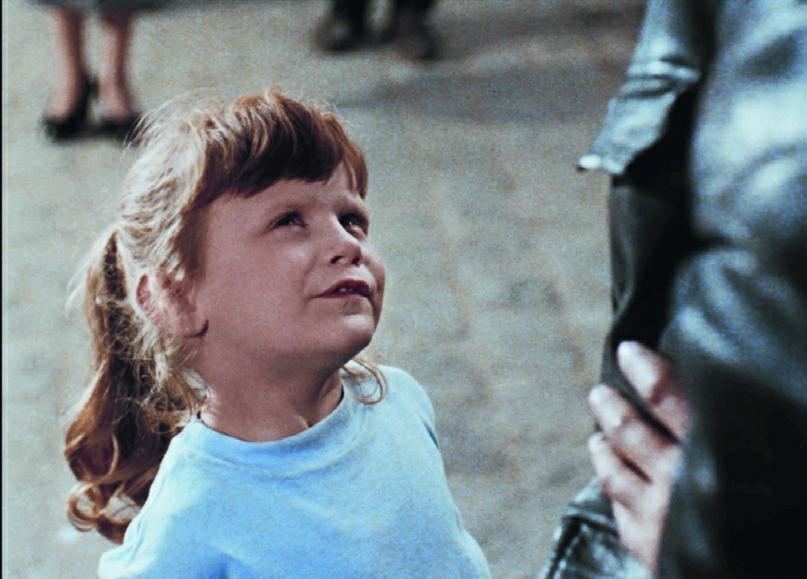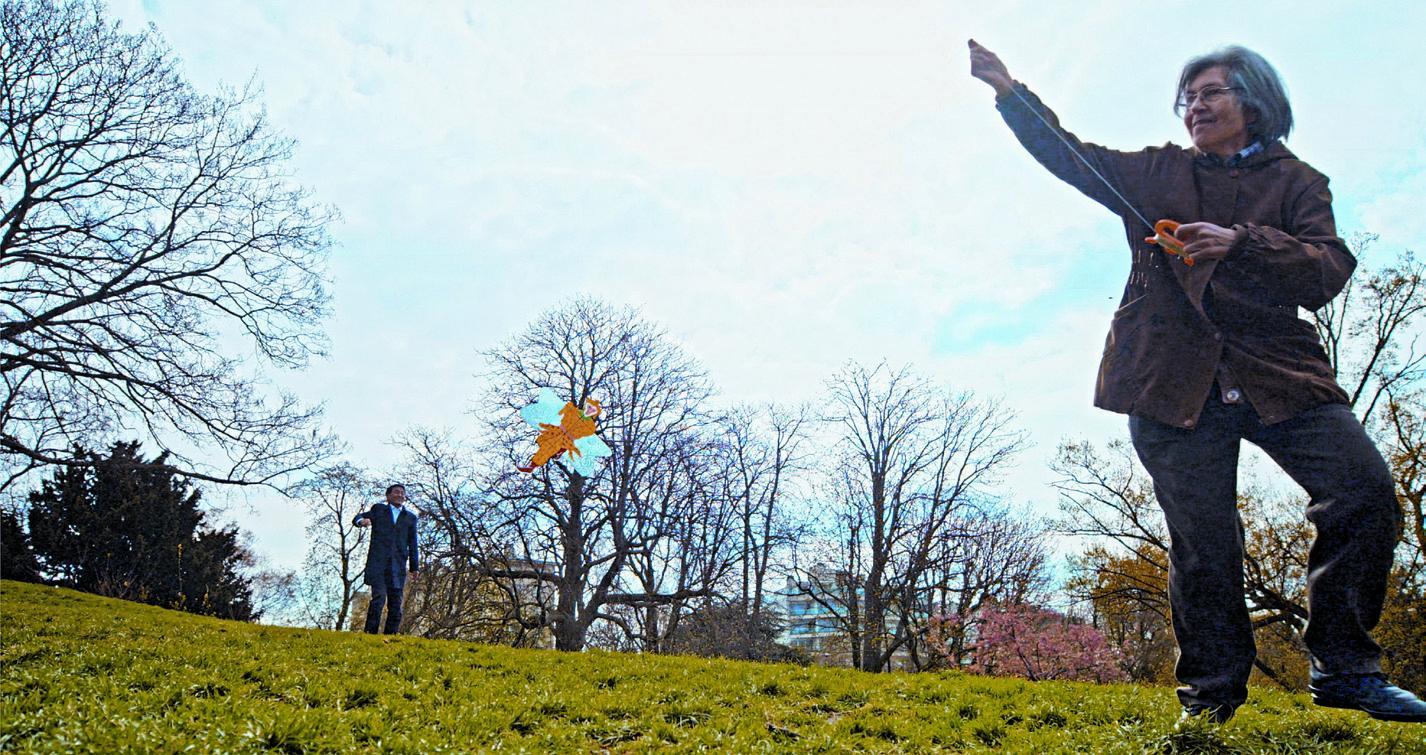A Tale of Two Kites
By LI YONG


A Trip of Communication
In 2019, French television network TV5 Monde aired a TV program celebrating the 55th anniversary of the establishment of China-France diplomatic relations. In the program, the production team intercut with an old photo of a little French girl sitting beside the late Chinese Premier Zhou Enlai, and asked the audience to offer information about this girl.
The little girl in the photo was Sylviane Rozenberg. At the time of the photo, she was five years old and was playing the role of the heros sister, Nicole, in The Magic of the Kite. She had been out of the public eye for many years since then. The information was asked for by a Chinese production team, which planned to reunite the main cast of the childrens film and relive the story 60 years ago.
Even more interesting than this, when the original film The Magic of the Kite was produced, the French director Roger Pigaut selected the leading characters after airing a recruitment advertisement on the radio. The casting criteria were specific. The actor who played the role of the young hero Pierrot must be around 10 years old and have freckles on his face. When Roger Pigaut went out of his house, more than 100 boys who met the relevant physical requirements were gathered at his door. Patrick de Bardine was chosen from the group of boys to play Pierrot.
A key word for the production of The Magic of the Kite was “searching.” The film tells a simple story of two French children, who with the help of the Monkey King in Chinese mythology, went to search for the owner of a kite, a Chinese boy named Song Xiaoqing.
Another key word demonstrated in the film is “friendship.” In 1957, the Peoples Republic of China (PRC) had only been founded for less than 10 years, and China and France had not yet established diplomatic relations. In the movie, the journey of the French boy Pierrot and his sister Nicole to Beijing symbolized the communication between the Western countries and the PRC. This movie was released in both France and China in 1958 and 1959. A few years later in 1964, China and France established diplomatic relations. In 1973, Georges Pompidou, then President of France, visited China and said that arts and film had done much to promote diplomacy, and the movie co-produced by China and France promoted people-to-people exchanges between the two countries.
Roger Pigaut was a member of the French Communist Party and was also on the film committee of the France-China Friendship Association. He had long planned to create a childrens movie about China. In The Magic of the Kite, he used the symbol of a kite connecting Beijing and Paris to show the friendship between the children of both countries. In 1955, he wrote a letter to then Chinas film administration, in which he explained his filming idea. He received the support of Wang Lanxi, then director of the administration. After Premier Zhou Enlai learned of the matter, he also gave his full support to the film production.
In Chinese culture, kites are not only used as a toy for leisure enjoyment, but also represent a cultural aspiration of exploring loftiness and seeking the unknown. By using the image of the kite, Roger Pigaut also found a bridge to connect Chinese and French film creators.
During the Cold War, art performances often played an important role in people-to-people exchanges. During the 1950s, Zhang Chunhua, a famous Peking Opera artist, performed in Europe twice, becoming very popular among French people. Roger Pigaut happened to be one of his audiences and was amazed by the power of the Monkey King.
Roger Piguat had a friend who was a famous documentary director — Joris Ivens. Ivens visited China many times between 1955 and 1957. It is said that once he took back a kite with the image of the Monkey King, which inspired Roger Piguat once again. In the end, the Monkey King became an important role in The Magic of the Kite and presented a refreshing view of China to the Western audience.
A Simple and Successful Model of Cultural Communication
The Magic of the Kite was new Chinas first color childrens feature film. It was also the first co-production with foreign directors and actors after the PRC founding. It opened a new chapter for Chinas cooperation and exchanges with foreign countries in film making. The film won awards at the Karlovy Vary International Film Festival and Venice International Film Festival in 1958.
Pierre Lhomme, assistant photographer of this movie, later became a famous cinematographer. He won the César Awards, twice for his masterpieces Camille Claudel and Cyrano de Bergerac. When he shot the kite film in 1957, he was 27 years old. The young French man came to China and had good memories when working with the Chinese team.
At that time, Lhomme had two Chinese assistants. Although they had language difficulties in communicating, they always smiled at each other to show understanding and made gestures while operating the camera. Lhomme recalled that they encountered a problem with one of the camera parts. It was difficult to find a replacement for it. But the assistants told him that everything would be fine. The next morning, they brought him a new part that they had worked the whole night to make. If they had not fixed that problem, Lhomme would have had to ship the small part from France. Thats really a professional present, said Lhomme.
When the filming ended, Lhomme and his assistants cried when they parted. More than 50 years later, Lhommes eyes could not help but brim with tears as he related this experience during an interview. In addition to the filming, he was also impressed by what he saw in Beijing. As it was his first visit to China, being a European, he was absolutely fascinated and amazed at everything.
The Magic of the Kite proved to be a hit both in China and France. Film historian George Sadoul said that the film was filled with fantasy and friendship, attracting children as well as adults. It allowed people to see the romance of Beijing and Paris through childrens eyes, Sadoul said.
The Magic of the Kite has been shown in schools in France for more than 30 years, becoming the first window for generations of French people to learn about China. When Vincent Perez, a famous French movie star, promoted Fanfan in China, he said that it was after seeing scenes of China for the first time in The Magic of the Kite that he resolved that he was going to visit the magical land one day.
The popularity of the movie has made it a symbol of the friendship between the Chinese and French people. On diplomatic occasions and in activities for people-to-people exchanges, which took place after the films production, the film has often been used as the opening movie or made into gifts. People from both countries can always find a common topic of interest when they mention this movie.
Reuniting after 60 Years
On the 60th anniversary of its release in 2018, a Chinese documentary team launched a tour to revisit the cast of the movie.
In order to find the actors who played in the movie, directors Xin Shaoying and Xu Feng posted a notice on TV and also asked Chinese residents in France to help look for them. They were lucky enough to find Hua Weimin who played the role of Zhou Peiqin, Sylviane Rozenberg for Nicole, and Liu Xiangsheng for the kite owner Song Xiaoqing. Then, the documentary team made a reunion that connected two centuries.
After learning about the plan to shoot for the reunion in France, Liu ordered a kite with the same image of the Monkey King that was on the kite 60 years ago. This time, he would take it back to France.
The production team held a reunion meeting in Paris on March 24, 2019. Sylviane Rozenberg recalled her good old days with Chinese friends during the filming. She said that every time she was tired, there was a young actor who carried her on his back. Another young girl always translated for her from Chinese into French.
Liu Xiangsheng was the boy who always carried Sylviane on his back, and Hua Weimin was the translating girl. Both of them are now septuagenarians. It was quite a moving moment when the three old friends met once again at the meeting.
The documentary team followed Liu as he visited Sylvianes family and saw her collection of posters and photos. She also played the French version of The Magic of the Kite for the team. After that, she took them to the shooting location in Montmartre again and flew a kite with Liu.
Liu said that he had wanted many times to find the young actors when he is a grown man, but it was too difficult. He traveled to France and learned about local culture, and found that both Chinese and French cultures are great cultures.
The Documentary of Kite·Kite
From planning to shooting, the production of the documentary Kite·Kite took one and a half years to complete, during which the crew conducted interviews in Paris, Marseille, Lyon, and Avignon in France, as well as in Beijing, Weifang, Shanghai, and Guangzhou among other places in China.
The production of the documentary was an exciting experience. In addition to interviews of the actors in the original film, the team also talked with Wang Xiaolian, daughter of the Chinese director of The Magic of the Kite Wang Jiayi, Vivianne Montagnon, girlfriend of the films French scriptwriter Antoine Tudal, Zhang Xiaohua, son of the actor of the Monkey King Zhang Chunhua, and legendary Monkey King actor Zhang Jinlai, also known as Liu Xiao Ling Tong.
In addition to this, the team also videoed many artists, such as Guo Gan, an erhu musician who composed the song Kite, Wang Han, an artist residing in France who created a series of paintings on the theme of kites, Jean-Michel Jarre, the first Western musician who was invited to perform in China after 1978, and Sophie Marceau, a famous French actress who introduced The Magic of the Kite to be used as the opening film at the Beijing International Film Festival. The documentary showed more than 20 artists, each of whom presented the culture of kites in their own way, reflecting several decades of cultural exchanges between the two countries.
The documentary also reveals new scenes of China and France. Sixty years ago, The Magic of the Kite involved fictional plots, but the scenes were real. The film showed classical Chinese landscapes, such as the Palace Museum, Beihai Park, and Jingshan Park, as well as introduced people in the Western world to the simple daily life of Beijing people living in the 1950s.
Todays documentary presents typical modern Chinese cities. It has provided another opportunity for the two nations to understand each other.
Xu Feng, a director of the documentary, said the documentary has demonstrated the deep-rooted friendship that the Chinese and French people enjoy, which will stretch beyond mountains and oceans into eternity.

